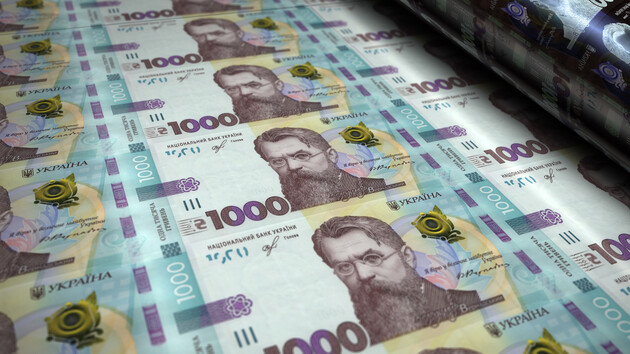What should we do with the printed hryvnia?
The government's recipe is simple - as much funding from abroad as possible. Fortunately, despite the persistent desire to dress Ukraine in the clothes of a beggar, this is not true. We have the potential of local capital for recovery, and we must use it to at least somehow compensate for the negative impact of printed money on the economy. What would be useful to us? To begin with, it would be good to increase the circulation of money in the economy.
Currently, the government solves the problem of money shortage exclusively by printing it and obtaining it from extra-budgetary sources. If no alternatives are found, it will eventually lead to hyperinflation and collapse. Here we would need a significant increase in the circulation capacity of those funds that have already been printed. This is a complex task that goes beyond the stereotyped thinking of officials. Currently, it seems that only the NBU is thinking about its solution, for the rest of the economic block it is not a priority at all, because in fact, so far none of the points of the so-called recovery plan focuses on the intensification of the turnover of monetary funds, on the so-called monetary aggregates.
What it is? When you buy a croissant in the morning, the baker orders the products for its preparation and pays the salary, the supplier buys gasoline with the same funds, the trader orders this fuel from his counterparty, who, for example, pays the bank interest, and the bank also puts into circulation the same funds. And around that there are the rest of the other transactions. As a result, the value of your croissant multiplies, triggering a large number of other economic chains. Under such conditions, even printed money may not harm (or harm less) the economy.
That is why Ukraine is simply obliged to make a leap in the direction of structural reforms that ensure advanced principles and methods of work of markets, collaborations of these markets, creation of new ones.
And here is just one example of how you can combine two non-working markets and launch them with maximum profit.
Gamification of the capital market, that is, the use of game practices in a non-game context, occurred a long time ago. Its virtual prototype — the market of virtual assets — has been based on gamification from the very beginning. However, it suffers from significant volatility, i.e. price fluctuations.
On the other hand, the real estate market, on the contrary, has little volatility and historically in Ukraine always shows growth. This trend is objective. After the crisis, it recovers due to rapid fluctuations around, and especially at a fast pace, exceeding the normal growth of the price.
The solution for the economy arises from combining these two resources used with profit for the economy.
When today we talk about the high volatility of virtual, or intangible, assets, we have to pay attention to two factors: unsecured virtual assets, for example, cryptocurrencies, and secured virtual assets, for example, tied to securities or property. The problems of the virtual asset market as a self-sufficient, developing phenomenon are inevitable. However, there are no alternatives to it. The only problem is understanding and working with the essence of this market. By reducing the share of unsecured and reducing the volatility of instruments.
The real estate market will give virtual assets the credibility of instruments with its material basis. The virtual asset market will add liquidity to the real estate market and can connect with other financial markets.
The crisis in the real estate market, however, just like the crisis in the market of virtual assets, can and should be resolved due to its real transformation from a market for speculators to a market for private investors and developers. Before the war (now - no one), it was the speculators who took all the business, evading, in fact, fair taxation. The end consumer suffered, the small investor was deprived of the opportunity to invest, and developers were dependent on elastic demand.
Thus, the dynamics of the change in the price index for primary market housing in Ukraine, cumulatively, was 149.7% from December 2015 to December 2021. At the same time, last year the cost of housing on the same primary market increased by almost 10% (according to the State Statistics Service) compared to 2020. So, despite this, we will see that growth always happens, because it is a trend. At the same time, for a considerable time during this period, growth occurred below the trend (it is about 8.1%), sometimes it fell altogether, but the value still increased.
Today there are no statistics on this dynamic, because the market has frozen. At the same time, the market built according to the old rules will no longer exist. The old investment tools (derivatives, to be honest, they were more in form, buying large volumes directly from the developer by big money speculators does not work due to changes in taxation, etc.) do not work. There are no new ones. Moreover, there are no tools that could attract not only the final consumer, but also the small investor. And, yes, not only from Ukraine. If we assume that one job in this market correlates to seven jobs in other industries, then we have to conclude that the economy has stopped at a crazy rate. Unblocking this process will not only provide an opportunity to engage the industry, but will also significantly increase turnover in the new market. We have to calculate how exactly the money aggregates will increase in this case, but it will be growth — not borrowing, not printing money.
The idea is great, but why the government doesn’t do it? Especially since the entire Law «On Virtual Assets» has already been adopted. It would seem that there is no problem – just go ahead, work! Tokenization of the economy is happening in the world at a frantic pace. Let's note once again — tokenization, for example, by introducing NFTs into circulation, which are secured assets, is a luxurious instrument: it is impossible to fake, it is difficult to default.
But no. The law was adopted, but it has not came into force. And if it comes into force, it will be a law that will prohibit rather than allow. And in case it allows, then everything will be regulated by the authorized body — the National Securities and Stock Market Commission (NSSMC), which has proven its harm to the economy and its ability to fail everything that was entrusted to this commission over the years.
Nobody is against transparent rules. But just rules, not prohibitions.
The NSSMC is an odious and unconstitutionally created body. A monster who spends money from taxpayers' pockets on idleness, creating the appearance of work (because in fact, it has nothing to regulate, because the "capital pipeline" has never worked). Its head is also appointed by presidential decree contrary to the Constitution. Just don't say you didn't know! The president is not guilty, he acted on the basis of the law, but it turned out that the law contradicts the Constitution. Where does the trust in such a body come from? Especially if it not only in theory, but also in practice demonstrates total incompetence in promoting reforms, and what it does today is generally a secret covered in darkness.
The National Commission is probably the only state body that completely banned access to public information and, it seems, stopped any work at all, except for the business trips of its head to EU countries (shock and trash). In Great Britain during the Second World War, the stock market was closed for only a few days. In Ukraine, obviously, to victory. Well, there is no regulator, maybe there will be other proactive ones? Are we seeking reconstruction, or not?
When the so-called recovery plan was drawn up, I proposed to create a capital market group in it but it was not created. The reason will be quoted: «There is no information for your request.». As a matter of fact, this innocent answer demonstrates the complete absurdity of the institutions responsible for the economy in Ukraine.
But in case the government will still find time and inspiration, because we have proposals on what needs to be done to use internal reserves and at least try to mitigate the devastating impact of the emission.
To compile and provide an algorithm for the entry into force of the Law of Ukraine «On Virtual Assets». To take urgent steps to ensure the functioning of capital markets: align the powers of the market regulator with the Constitution.
Proposal: NSSMC should be completely liquidated, the authority to regulate capital markets and virtual assets should be transferred to the National Bank of Ukraine, where proper departments should be created. By the way, we have an example from the NSSMC. And again, by the way, in Germany and other countries, one regulator regulates a much larger volume of financial markets, and it works. Is Ukraine more specific to complicate things?
To ensure the intensification of the virtual asset market in a new, high-quality format with the participation of the Ministry of Digital Transformation of Ukraine. To appoint a person in the government responsible for the project of this reform.
Why is this important? Because currently the government together with the NSSMC have effectively deprived the people of any means and mechanisms of investment, in general, the multiplicity of sources of income. At the same time, it seems that they do not understand that the issue is not about restricting some individual consumers, because, after all, such restrictions affect the economy at the global level. Even having funds here in the country, we cannot use them effectively, which leads to self-limitation of own economy.
Read this article by Oleksandr Koshoviy in russian and Ukrainian.
Please select it with the mouse and press Ctrl+Enter or Submit a bug












 Login with Google
Login with Google